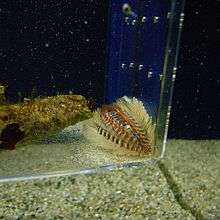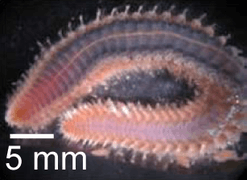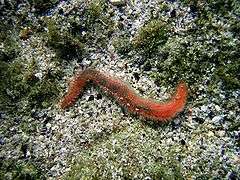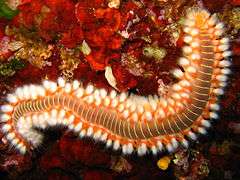Amphinomidae
| Amphinomidae Temporal range: Carboniferous – Recent[1] | |
|---|---|
.jpg) | |
| Hermodice carunculata | |
| Scientific classification | |
| Kingdom: | Animalia |
| Phylum: | Annelida |
| Class: | Polychaeta |
| Order: | Aciculata |
| Family: | Amphinomidae |
Amphinomidae is a family of marine polychaetes, many species of which bear chaetae mineralized with carbonate.[2] The best-known amphinomids are the fireworms, which can cause great pain if their toxin-coated chaetae are touched or trodden on.[3] Their relationship to other polychaete groups is somewhat poorly resolved.[3]
Complanine
Complanine is an quaternary ammonium salt that has been isolated from the marine fireworm Eurythoe complanata. It causes an inflammatory effect upon contact with the skin or mucous membranes.
It was previously known that handling the fireworm caused it to release a chemical that induces inflammation of the skin of marine predators and mammals (including humans). Complanine was the first compound isolated from the fireworm which causes these effects.[4][5] It is presumed that this compound's function is to deter predators of the fireworm.
List of genera
- Amphinome Bruguière, 1789
- Amphinomides
- Ankitokazoa Alessandrello & Bracchi, 2005 †
- Archinome Kudenov, 1991
- Asloegia
- Bathychloeia Horst, 1910
- Bathynotopygos
- Benthoscolex
- Blenda
- Branchamphinome Hartman, 1967
- Chloeia Lamarck, 1818
- Chloenea
- Chloenopsis Fauchald, 1977
- Chloochaeta
- Colonianella
- Cryptonome Borda, Kudenov, Bienhold & Rouse, 2012
- Didymobranchus
- Eucarunculata
- Eucarunculatus
- Eurythoe Kinberg, 1857
- Hermodice Kinberg, 1857
- Hipponoe Audouin & Milne-Edwards, 1830
- Lenora
- Linopherus Quatrefages, 1865
- Lirione
- Millepeda
- Notopygos Grube, 1850
- Parachloeia
- Paramphinome Sars, 1869
- Pareurythoe Gustafson, 1930
- Pherecardia Horst, 1886
- Pherecardites
- Rostraria
- Sangiria
- Strategis
- Thesmia
- Thetisella
- Zothea
References
- ↑ Pleijel, F.; Rouse, G. W.; Vannier, J. (2004). "Carboniferous fireworms (Amphinomida : Annelida), with a discussion of species taxa in palaeontology". Invertebrate Systematics. 18 (6): 693. doi:10.1071/IS04003.
- ↑ Barroso, R. M.; Paiva, P. C. (2010). "A new deep-sea species of Chloeia (Polychaeta: Amphinomidae) from southern Brazil". Journal of the Marine Biological Association of the United Kingdom. 91 (2): 419. doi:10.1017/S0025315410001499.
- 1 2 Wiklund, H.; Nygren, A.; Pleijel, F.; Sundberg, P. (2008). "The phylogenetic relationships between Amphinomidae, Archinomidae and Euphrosinidae (Amphinomida: Aciculata: Polychaeta), inferred from molecular data". Journal of the Marine Biological Association of the UK. 88 (3). doi:10.1017/S0025315408000982.
- ↑ Kazuhiko Nakamura; Yu Tachikawa; Makoto Kitamura; Osamu Ohno; Masami Suganuma; Daisuke Uemura (2008). "Complanine, an inflammation-inducing substance isolated from the marine fireworm Eurythoe complanata". Org. Biomol. Chem. 6 (12): 2058–2060. doi:10.1039/b803107j. PMID 18528565.
- ↑ Nakamura, Kazuhiko; Tachikawa, Yu; Uemura, Daisuke (2009). "(−)-Complanine, an inflammatory substance of marine fireworm: a synthetic study". Beilstein Journal of Organic Chemistry. 5. doi:10.3762/bjoc.5.12.
External links
- "Family Amphinomidae "FIREWORMS"". Raffles Museum of Biodiversity, National University of Singapore. Retrieved 31 December 2013.
| Wikimedia Commons has media related to Amphinomidae. |
.jpg)




